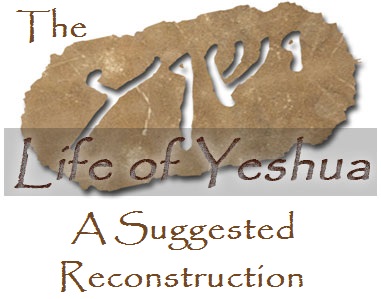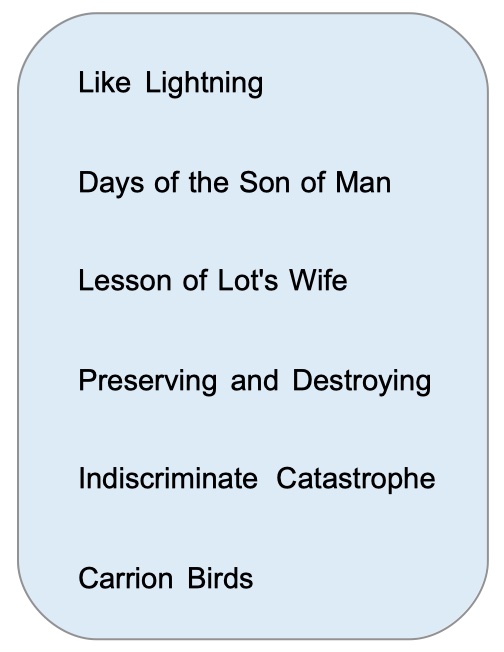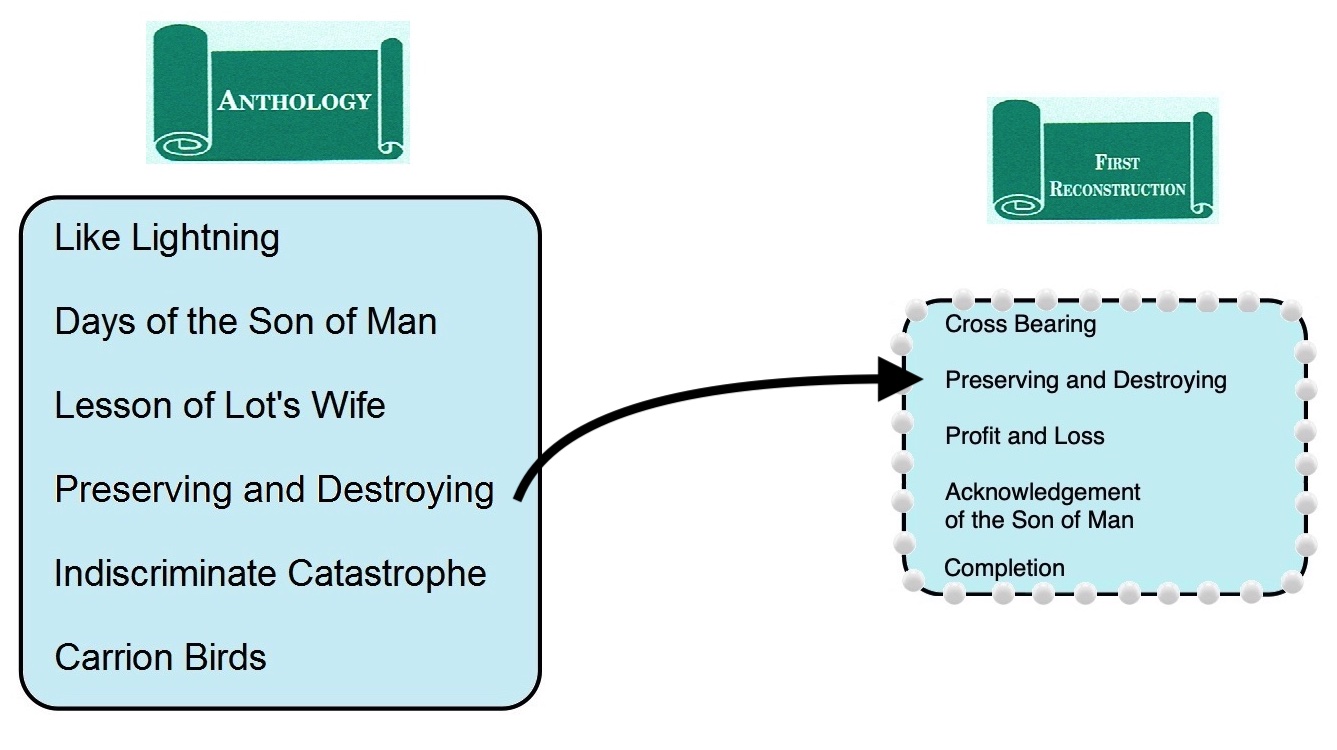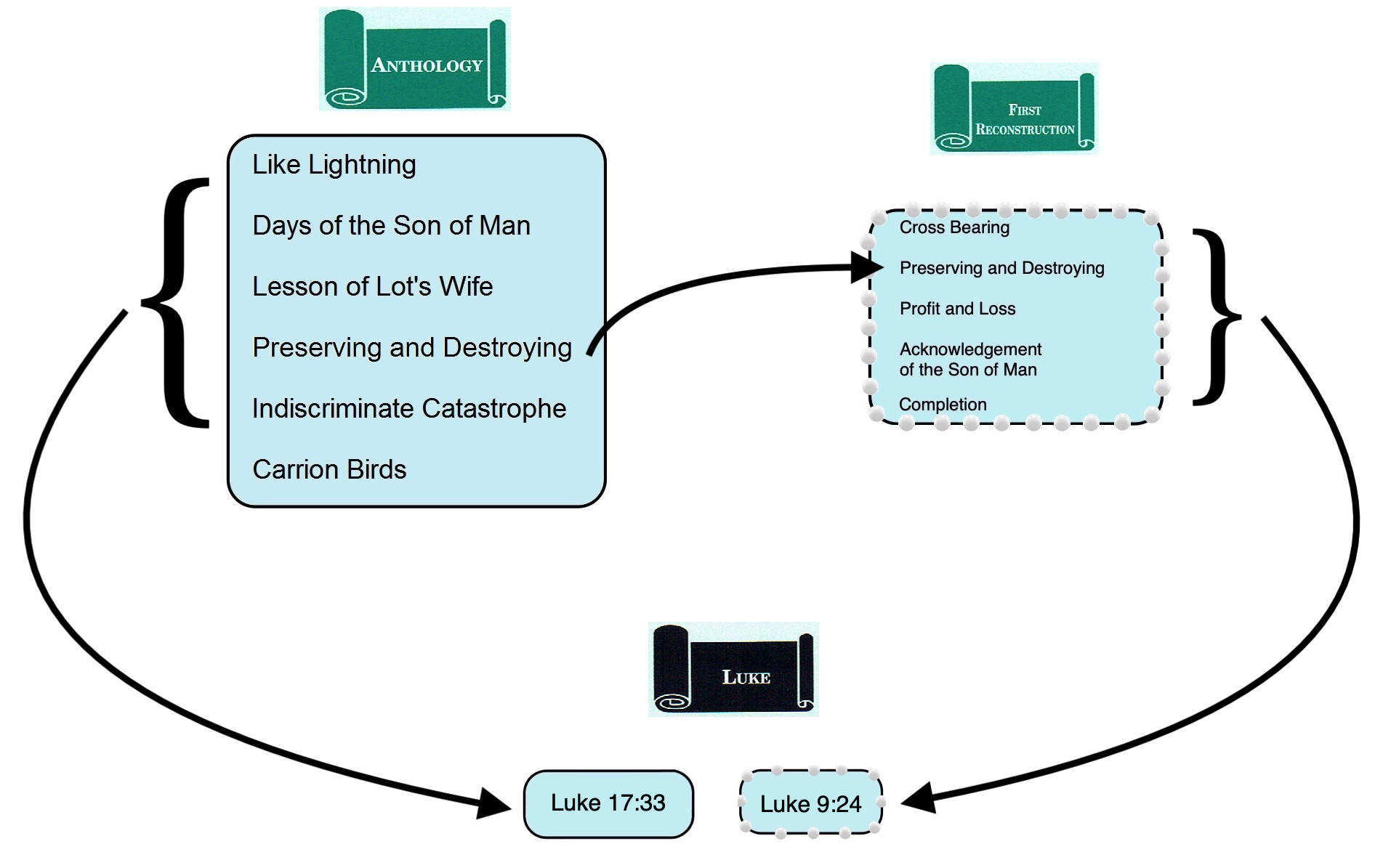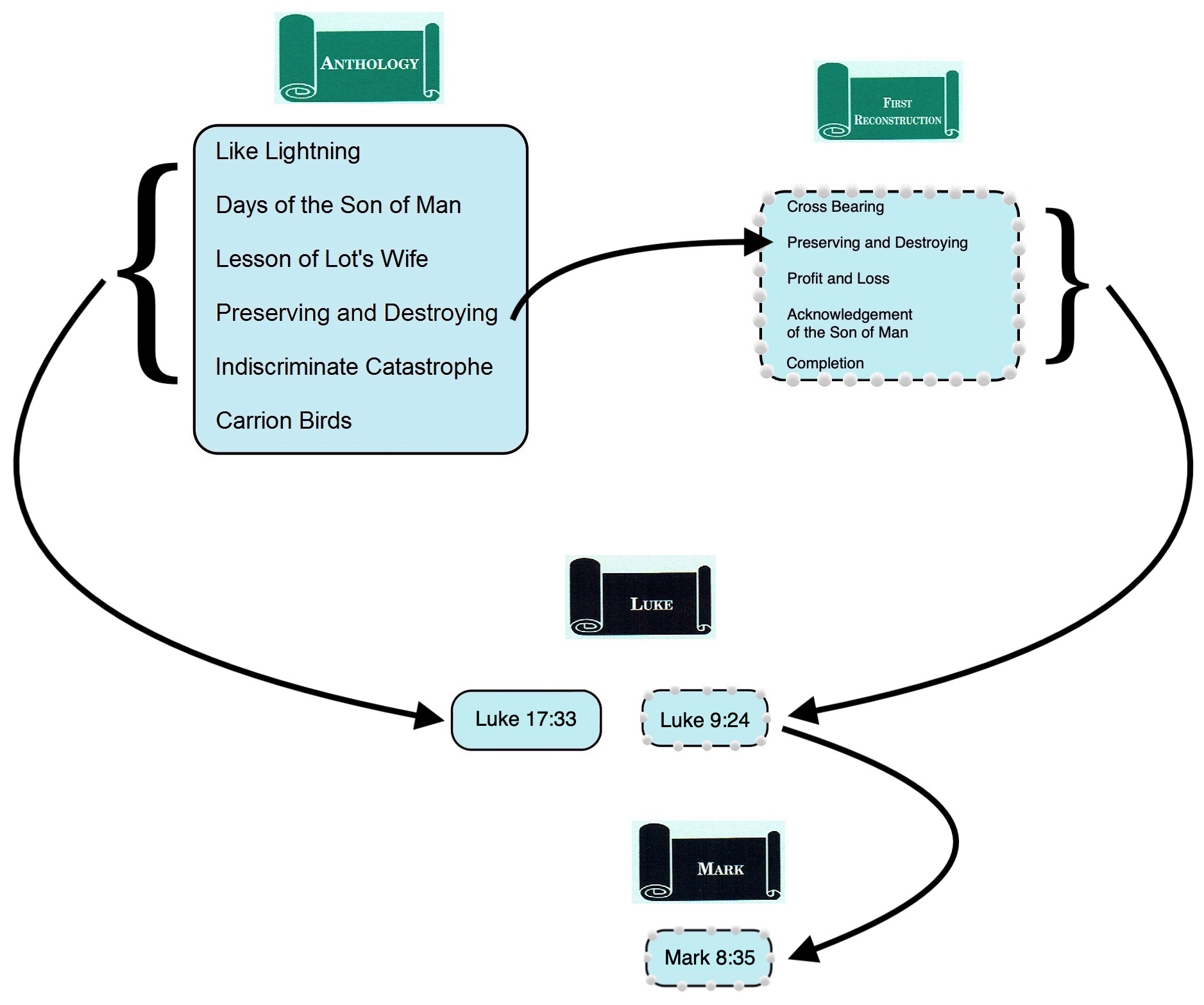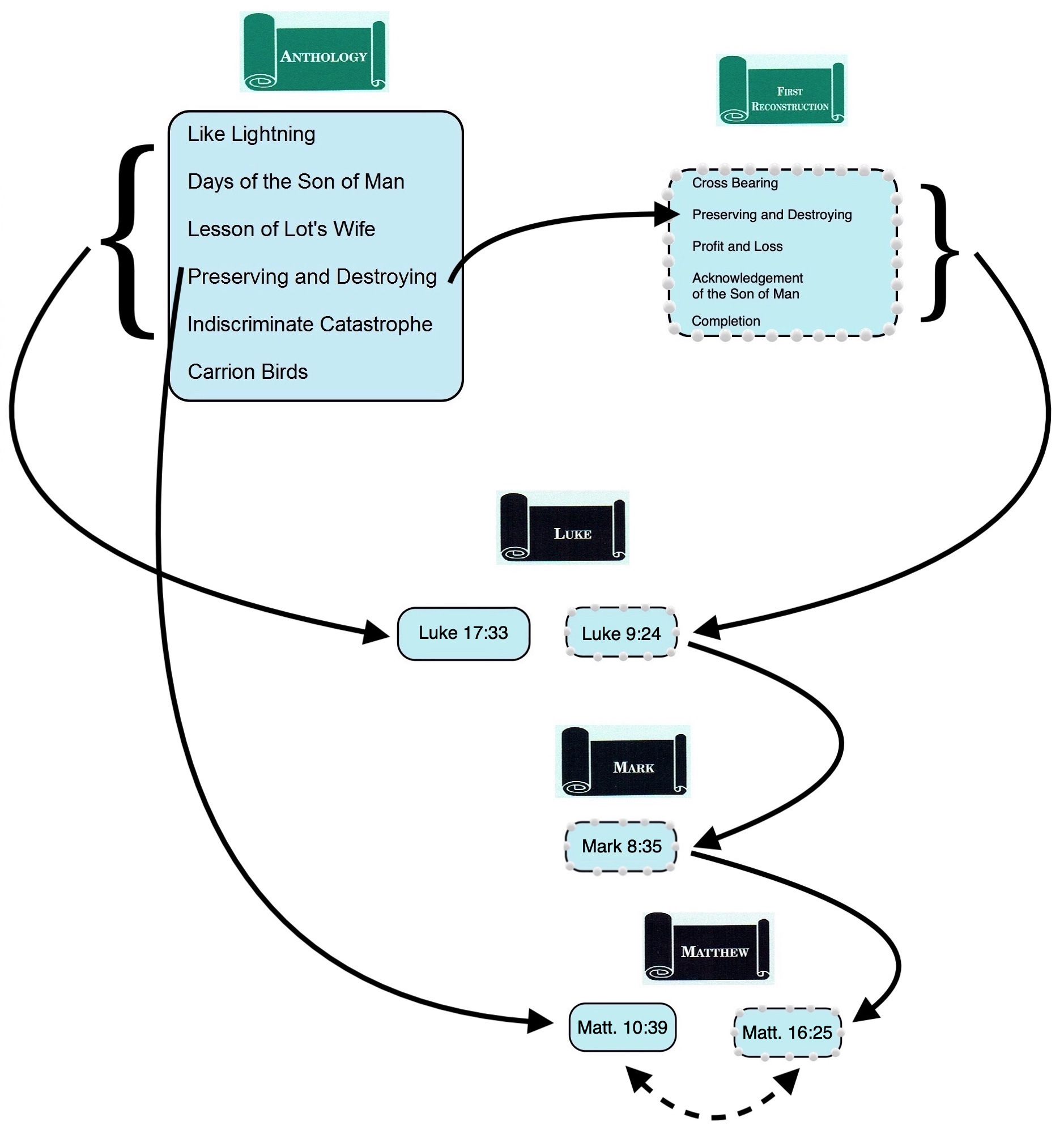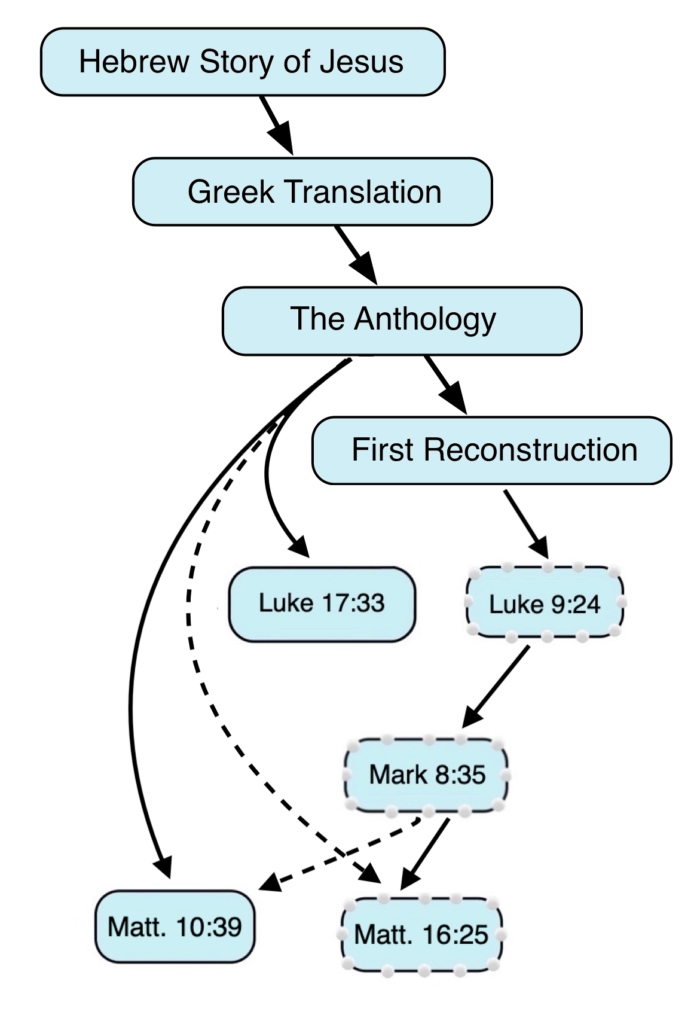Matt. 10:39; 16:25; Mark 8:35;
Luke 9:24; 17:33[1]
Updated: 4 December 2025
מִי שֶׁיְּבַקֵּשׁ לְמַלֵּט אֶת נַפְשׁוֹ יְאַבְּדֶהָ וּמִי שֶׁיְּאַבֵּד אֶת נַפְשׁוֹ יְקַיְּמֶהָ
“Whoever wants to preserve his life when the calamity strikes will have to destroy his attachment to possessions, but whoever does forsake his possessions will live to see another day.[2]
| Table of Contents |
|
3. Conjectured Stages of Transmission 5. Comment 8. Conclusion |
Reconstruction
To view the reconstructed text of Preserving and Destroying click on the link below:
In addition to our reconstruction, we note that Menahem Kister proposed the following reconstruction of Preserving and Destroying:
המבקש לקיים את נפשו יאבדנה והמאבד את נפשו יקיימנה
The one who wishes to preserve his life must destroy it. And the one who destroys his life will preserve it.[3]
Story Placement
Given the presence in the Synoptic Gospels of five versions of the pericope we have entitled Preserving and Destroying, it can be difficult to determine where this saying might have belonged in the Hebrew Life of Yeshua. Nevertheless, there are certain indications to suggest that it is the version in Luke 17:33 that preserves the original context of Preserving and Destroying.[4]
In the first place, the Luke 17:33 version of Preserving and Destroying appears in the middle of a block of Son of Man material that the author of Luke copied from the Anthology (Anth.).[5] While the Anthologizer was known for separating teachings from incidents and parables from teachings, it was not the Anthologizer’s habit to scramble the contents of the smaller units he created. Thus, the Anthologizer preserved twin parables in pairs,[6] and medium-to-large-sized blocks of teaching materials are preserved in their original sequence (e.g., the Sending the Twelve discourse, the Anth. block on Prayer and the Anth. block on John the Baptist). The Anthologizer would attach extraneous material to the beginning or end of these blocks,[7] but it was generally not his practice to inject originally unconnected materials into the middle of a block.[8] So unless the author of Luke was responsible for injecting Preserving and Destroying into the middle of Anth.’s Son of Man block,[9] the chances are good that Anth. preserves the original location of Preserving and Destroying relative to the pericopae surrounding it.[10]
In the second place, parallels in rabbinic sources demonstrate that there is a coherence to the placement of Preserving and Destroying in Luke 17:33. In Days of the Son of Man (Luke 17:26-30) Jesus compared the obduracy of his generation to the heedlessness of the people in the days of Noah and to the stubbornness of the Sodomites in the days of Lot. In each case, the contemporaries of Noah, Lot and the Son of Man ignored warnings of a coming catastrophe. In Lesson of Lot’s Wife (Luke 17:31-32) Jesus advised his contemporaries that when the catastrophe finally strikes they should flee without turning back to collect their belongings. Failure to abandon their property could result in tragedy, just as it had for Lot’s wife, who turned back while fleeing from Sodom. On its surface Preserving and Destroying’s connection to the story of Lot is not obvious, but when aggadic traditions concerning Lot’s flight from Sodom are taken into consideration, the connection to Preserving and Destroying begins to emerge.
According to rabbinic traditions, Lot’s attachment to his possessions endangered his life as well as the lives of his wife and daughters. Because he was unwilling to part with his belongings, the angels sent to destroy Sodom had to drag him out of the city. As one aggadic tradition states:
ויתמהמה [ויחזקו האנשים בידו וביד אשתו וביד שתי בנתיו] תמהון אחר תמהון, אמר כמה אבוד בכסף וזהב באבנים טובות ומרגליות הה″ד עושר שמור לבעליו לרעתו, ר′ יהושע בן לוי אמר זה לוט
And he lingered [and the men seized him and his wife and his two daughters by the hand] [Gen. 19:16]. Hesitation after hesitation.[11] He said, “What loss [or destruction—DNB and JNT][12] of silver and gold, of jewels and pearls!” As it is written, wealth guarded by its owner to his harm [Eccl. 5:12]. Rabbi Yehoshua ben Levi said, “This is Lot.” (Gen. Rab. 50:11 [ed. Theodor-Albeck, 2:528])
In another source the angels rebuke Lot for his attachment to his belongings saying, דייך שתמלט את נפשך (“It ought to be enough for you that you will preserve your life!”; t. Sanh. 14:4).[13]

These rabbinic traditions show how Preserving and Destroying might echo the story of Lot. In order to preserve his life Lot had to forsake his property. Preserving and Destroying applies this lesson to Jesus’ generation. When the inevitable clash with the Roman Empire finally takes place, there will be no time to waste on gathering one’s possessions. Whoever is unable to sever the bonds to his or her possessions will be caught up in the destruction. Whoever breaks free from his or her attachment to their belongings will have a chance to escape to safety.
This interpretation of Preserving and Destroying presumes that Jesus’ saying plays off two different senses of the noun נֶפֶשׁ (nefesh, “soul”). One sense of נֶפֶשׁ is “life,” a meaning found in the angels’ rebuke, “It ought to be enough for you that you will preserve your life [נַפְשֶׁךָ]!” Another meaning of נֶפֶשׁ is “will” or “desire.”[14] If these two senses of נֶפֶשׁ are active in Preserving and Destroying, then we can understand Jesus’ saying to mean, “Whoever wants to preserve his life [נַפְשׁוֹ] must destroy his desire [= נֶפֶשׁ] (for his possessions), but whoever does destroy his desire [נַפְשׁוֹ] will preserve his life [= נֶפֶשׁ].”
Although paradoxical in form, in Hebrew Preserving and Destroying was more of a riddle than a paradox. A listener simply would have needed to realize that Jesus was playing on two meanings of the noun נֶפֶשׁ to have understood his saying, and this realization would not have been difficult because of the Lot motif that permeated the context in which Jesus uttered this saying. It was only in translation that Jesus’ saying became truly paradoxical, since ψυχή (psūchē, “soul”), the Greek equivalent of נֶפֶשׁ, does not have “desire” as a secondary meaning.[15] And precisely because in Greek translation Preserving and Destroying is more or less incomprehensible, it is highly improbable that the author of Luke, who only knew the saying in its Greek form, accidentally inserted it at precisely the right point where it makes the most sense from a Hebraic perspective. Thus we conclude that Preserving and Destroying is fully at home in the context where it is preserved in Luke 17:33.[16]
A second version of Preserving and Destroying appears in Luke 9:24, where it belongs to a collection of loosely related sayings (Luke 9:23-27) about the personal cost of following Jesus. This second version appears shortly after Petros’ Confession (Luke 9:18-21) and immediately after Jesus’ first passion prediction (Luke 9:22). Lindsey attributed such collections of loosely related sayings that are strung together like a set of pearls to the First Reconstructor.[17] Similar collections appear in Luke 8:16-18 and Luke 16:16-18.[18] It is FR’s version of Preserving and Destroying that was picked up by the author of Mark (Mark 8:35), who, like Luke, preserved it in the context of Petros’ Confession and Jesus’ passion prediction. The author of Matthew in turn copied this version of Preserving and Destroying (Matt. 16:25) in its FR context from Mark. Matthew’s Gospel, however, contains yet another version of Preserving and Destroying, this one being embedded in the Matthean version of the Sending the Twelve discourse (Matt. 10:39). It is likely that Matthew includes two versions of Preserving and Destroying because the author of Matthew found different versions in each of his sources (Mark and Anth.), but due to his procedure of cross-pollination, the version of Preserving and Destroying taken from Mark has “contaminated” the version based on Anth. (and vice versa). In any case, the location of Preserving and Destroying in the Sending the Twelve discourse is due to the author of Matthew’s editorial expansion of the discourse[19] and is not a reflection of its placement in Anth.
.
.
Click here to view the Map of the Conjectured Hebrew Life of Yeshua.
.
.
Conjectured Stages of Transmission
The stages of Preserving and Destroying’s transmission have already been discussed in the Story Placement section above. The Anthologizer kept Preserving and Destroying in its original location following Lesson of Lot’s Wife. The First Reconstructor isolated Preserving and Destroying, paraphrased it using distinctively FR terminology (see below, Comment to L3), added a christological aspect to the saying (see below, Comment to L7), and included it in a “string of pearls” relating to the personal cost of following Jesus,[20] which he placed following Petros’ Confession and a passion prediction. The author of Luke copied the two versions of Preserving and Destroying in the contexts in which he received them. The author of Mark copied the FR version of Preserving and Destroying from Luke, and the two versions of Preserving and Destroying in Matthew are cross-pollinated hybrids of the versions he found in Mark and Anth.
Crucial Issues
- Is Preserving and Destroying a saying about risking one’s life for Jesus?
Comment
L1 ὃς ἐὰν ζητήσῃ (GR). The Anth. version of Preserving and Destroying (Luke 17:33) and the FR versions (Luke 9:24; Mark 8:35; Matt. 16:25) differ with regard to the verb in L1. Luke’s Anth. version has ζητεῖν (zētein, “to seek”), while the FR versions have θέλειν (thelein, “to wish”). Since “seeking” to do something is a Hebraic way of expressing “wishing” or “wanting” to do something,[21] and since we have identified other instances where the First Reconstructor replaced Anth.’s ζητεῖν with θέλειν,[22] we are confident in concluding that ζητεῖν is the verb that appeared in Anth.
The First Reconstructor would have found changing Anth.’s ζητεῖν to θέλειν to be advantageous not only because it yielded better Greek, but also because it served to link his paraphrase of Preserving and Destroying to the preceding saying (the FR version of Demands of Discipleship), which he also opened with the verb θέλειν (εἴ τις θέλει ὀπίσω μου ἔρχεσθαι [ei tis thelei opisō mou erchesthai, “If someone wants to come after me”]; Luke 9:23).
The outlier in L1 is ὁ εὑρών (ho hevrōn, “the one finding”; Matt. 10:39). Although this aberrant reading is the product of Matthean redaction,[23] it may bear indirect witness to the originality of ζητεῖν in L1. The collocation of ζητεῖν (“to seek”) and ἀπολλύειν (apollūein, “to lose”) in Anth.’s version of Preserving and Destroying may have been what suggested to the author of Matthew the idea of “finding,” which is unique to the Matthean versions of this saying.
מִי שֶׁיְּבַקֵּשׁ (HR). On reconstructing ὃς ἐάν (hos ean, “whoever”) with -מִי שֶׁ (mi she-, “who that”), see Yohanan the Immerser’s Question, Comment to L45.
On reconstructing ζητεῖν (zētein, “to seek”) with בִּקֵּשׁ (biqēsh, “seek,” “ask”), see Hidden Treasure and Priceless Pearl, Comment to L12.
L2 τὴν ψυχὴν αὐτοῦ (GR). The two Lukan versions and the two Matthean versions of Preserving and Destroying are in agreement in reading τὴν ψυχὴν αὐτοῦ (tēn psūchēn avtou, “his soul”) in L2 against τὴν ἑαυτοῦ ψυχήν (tēn heavtou psūchēn, “his own soul”) in Mark 8:35. However, this reading in Mark 8:35 is not textually certain, as important MSS other than Vaticanus read τὴν ψυχὴν αὐτοῦ, which is the reading accepted in critical texts. It is possible, therefore, that τὴν ἑαυτοῦ ψυχήν in Mark 8:35 is a scribal correction rather than a change introduced by the author of Mark. In any case, the phrase τὴν ἑαυτοῦ ψυχήν is un-Hebraic in terms of word order and pronoun selection, and the Lukan-Matthean agreement to write τὴν ψυχὴν αὐτοῦ in L2 confirms our choice for GR.
L3 περιποιήσασθαι (GR). In L3 it is Luke’s Anth. version of Preserving and Destroying that is the outlier, with the verb περιποιεῖν (peripoiein, “to preserve”; Luke 17:33) as opposed to the three FR versions that use the verb σῴζειν (sōzein, “to save”). Aside from the a priori likelihood that Luke 17:33, which is based on Anth., reflects Anth.’s verb,[24] the fact that in other pericopae σῴζειν has been found to be the product of the First Reconstructor’s redaction[25] strongly inclines us in favor of accepting περιποιήσασθαι for GR. The change to σῴζειν suggests that the First Reconstructor understood Preserving and Destroying as a saying about a person’s eternal salvation rather than as advice concerning how to survive the coming clash with the Roman Empire.

לְמַלֵּט אֶת נַפְשׁוֹ (HR). Although in GR “his soul” (L2) precedes the infinitive (L3), Hebrew syntax dictates that “his soul” should follow it. Thus, the words in L2 of GR have their equivalent in L3 of HR. Since the Greek translation of the Hebrew Life of Yeshua did not always preserve Hebrew word order, we have not deemed it necessary to “correct” the word order in GR.
In LXX the verb περιποιεῖν (peripoiein, “to preserve,” “to keep safe”) is not especially common, but when it does occur it often does so as the translation of the ח-י-ה root in its various stems.[26] The hif‘il infinitive לְהַחֲיוֹת (lehaḥayōt, “to keep alive”) is a possible option for HR, especially since the phrase לְהַחֲיוֹת אֶת נַפְשִׁי (lehaḥayōt ’et nafshi, “to keep my soul alive,” i.e., “to save my life”) occurs in the story of Lot’s escape from Sodom (Gen. 19:19). However, if הֶחֱיָה (heḥeyāh, “keep alive,” “make alive”) had occurred in the Hebrew form of the saying it is difficult to imagine it standing beind anything other than ζῳογονεῖν (zōogonein, “to make alive,” “to preserve alive”), the verb that occurs in L9, since, with its ζω- (zō-, “life”) root, it is the natural equivalent to verbs formed from the ח-י-ה (= “life”) root.
Perhaps, therefore, we are better off seeking a verb not based on the ח-י-ה root with which to reconstruct περιποιεῖν. Fortunately, such a verb is readily found. The pi‘el verb מִלֵּט (milēṭ) not only means “preserve,” but the מ-ל-ט root occurs several times in the story of Lot’s escape from Sodom (Gen. 19:17 [2xx], 19, 20, 22) and once in connection with the noun נֶפֶשׁ (“soul”): הִמָּלֵט עַל נַפְשֶׁךָ (himālēṭ ‘al nafshechā, “Escape for your life”; Gen. 19:17). Both the meaning of מִלֵּט and its frequency in the story of Lot make it a strong candidate for HR.[27] In addition, we find the verb מִלֵּט in the angels’ rebuke of Lot recorded in rabbinic tradition: דַּיֶּיךָ שֶׁתְּמַלֵּט אֶת נַפְשֶׁךָ (“It ought to be enough for you that you will preserve your life!”; t. Sanh. 14:4). The only drawback for this option is that περιποιεῖν never occurs in LXX as the translation of מִלֵּט,[28] but this fact need not deter us, since there is no reason why the Greek translator of the Hebrew Life of Yeshua had to follow the Septuagint’s lead.
Another candidate for reconstructing περιποιεῖν is קִיֵּם (qiyēm, “preserve alive,” “keep alive”).[29] The meaning of קִיֵּם fits the context and agrees with Mishnaic Hebrew usage, the style of Hebrew in which we prefer to reconstruct direct speech. Nevertheless, there are two reasons we believe מִלֵּט is the better alternative for HR. First, מִלֵּט links Jesus’ saying to the story of Lot, whereas קִיֵּם does not. Second, while קִיֵּם is a reasonable equivalent of περιποιεῖν (peripoiein, “to preserve,” “to keep safe”), we think קִיֵּם works even better as a reconstruction for ζῳογονεῖν (zōogonein, “to make alive,” “to preserve alive”) in L9. The presence of two different Greek verbs in L3 and L9 probably reflects the use of two different Hebrew verbs, and since קִיֵּם seems best for L9 we are left with מִלֵּט for L3.
On reconstructing ψυχή (psūchē, “soul,” “life”) with נֶפֶשׁ (nefesh, “soul,” “life”), see Demands of Discipleship, Comment to L18.
L4 ἀπολέσει αὐτήν (GR). Since all five versions of Preserving and Destroying read ἀπολέσει αὐτήν (apolesei avtēn, “he will destroy it”) in L4, and since this phrase reverts easily to Hebrew, there is no reason to doubt that this was the wording in Anth.
יְאַבֵּדָהּ (HR). On reconstructing ἀπολλύειν (apollūein, “to lose,” “to destroy”) with אִבַּד (’ibad, “destroy”), see Days of the Son of Man, Comment to L21.
Examples of verbs formed from the א-ב-ד root used in conjunction with נֶפֶשׁ occur in the following verses:
וְכָל הַנֶּפֶשׁ אֲשֶׁר תַּעֲשֶׂה כָּל מְלָאכָה בְּעֶצֶם הַיּוֹם הַזֶּה וְהַאֲבַדְתִּי אֶת הַנֶּפֶשׁ הַהִוא מִקֶּרֶב עַמָּהּ
And every soul [הַנֶּפֶשׁ] who does any work on this very day, I will cause that soul [הַנֶּפֶשׁ] to perish [וְהַאֲבַדְתִּי] from among its people. (Lev. 23:30)
καὶ πᾶσα ψυχή ἥτις ποιήσει ἔργον ἐν αὐτῇ τῇ ἡμέρᾳ ταύτῃ, ἀπολεῖται ἡ ψυχὴ ἐκείνη ἐκ τοῦ λαοῦ αὐτῆς.
And every soul [ψυχή] who does work in that very day, that soul [ψυχὴ] will be destroyed [ἀπολεῖται] from its people. (Lev. 23:30)
שָׂרֶיהָ בְקִרְבָּהּ כִּזְאֵבִים טֹרְפֵי טָרֶף לִשְׁפָּךְ דָּם לְאַבֵּד נְפָשׁוֹת לְמַעַן בְּצֹעַ בָּצַע
Her princes among her are like wolves who tear prey to pour out blood to destroy [לְאַבֵּד] souls [נְפָשׁוֹת] for the sake of ill-gotten gain. (Ezek. 22:27)[30]
We believe it makes the most sense to interpret יְאַבְּדֶהָ (ye’abdehā) not as a simple future (“he will destroy/lose it”) but as a jussive (“let him destroy it” or “he must destroy it”).
L5 ὃς δ᾿ ἂν ἀπολέσῃ (GR). The agreement on the phrase ὃς δ᾿ ἂν ἀπολέσῃ (hos d’ an apolesē, “but whoever might destroy”) in the Lukan version stemming from Anth. and the Lukan and Matthean versions stemming from FR strongly recommends accepting this reading for GR. Mark’s ὃς δ᾿ ἂν ἀπολέσει (hos d’ an apolesei, “but whoever will destroy”) is nearly identical. The outlier, καὶ ὁ ἀπολέσας (kai ho apolesas, “and the one who loses”) in Matt. 10:39, is an adaptation modeled on the changes the author of Matthew made to L1. The changes the author of Matthew introduced in L1 and L5 transform Jesus’ saying about preserving and destroying one’s life into an esoteric saying about finding and losing one’s soul.
וּמִי שֶׁיְּאַבֵּד (HR). On reconstructing ὃς ἐάν (hos ean, “whoever”) with -מִי שֶׁ (mi she-, “who that”), see above, Comment to L1.
On reconstructing ἀπολλύειν (apollūein, “to lose,” “to destroy”) with אִבַּד (’ibad, “destroy”), see above, Comment to L4.
L6 τὴν ψυχὴν αὐτοῦ (GR). The phrase τὴν ψυχὴν αὐτοῦ (tēn psūchēn avtou, “his soul”) is missing in L6 of the Lukan version of Preserving and Destroying based on Anth. It is present, however, in the Lukan, Markan and Matthean versions stemming from FR. Since it is unlikely that the First Reconstructor, whom Lindsey described as an epitomizer and a stylistic polisher, would have unnecessarily added the redundant phrase τὴν ψυχὴν αὐτοῦ had it not been present in Anth., and since an underlying Hebrew source would have required an equivalent to τὴν ψυχὴν αὐτοῦ, we suspect that it was the author of Luke who eliminated τὴν ψυχὴν αὐτοῦ from L6 in Luke 17:33.
אֶת נַפְשׁוֹ (HR). On reconstructing ψυχή (psūchē, “soul,” “life”) with נֶפֶשׁ (nefesh, “soul,” “life”), see above, Comment to L3.
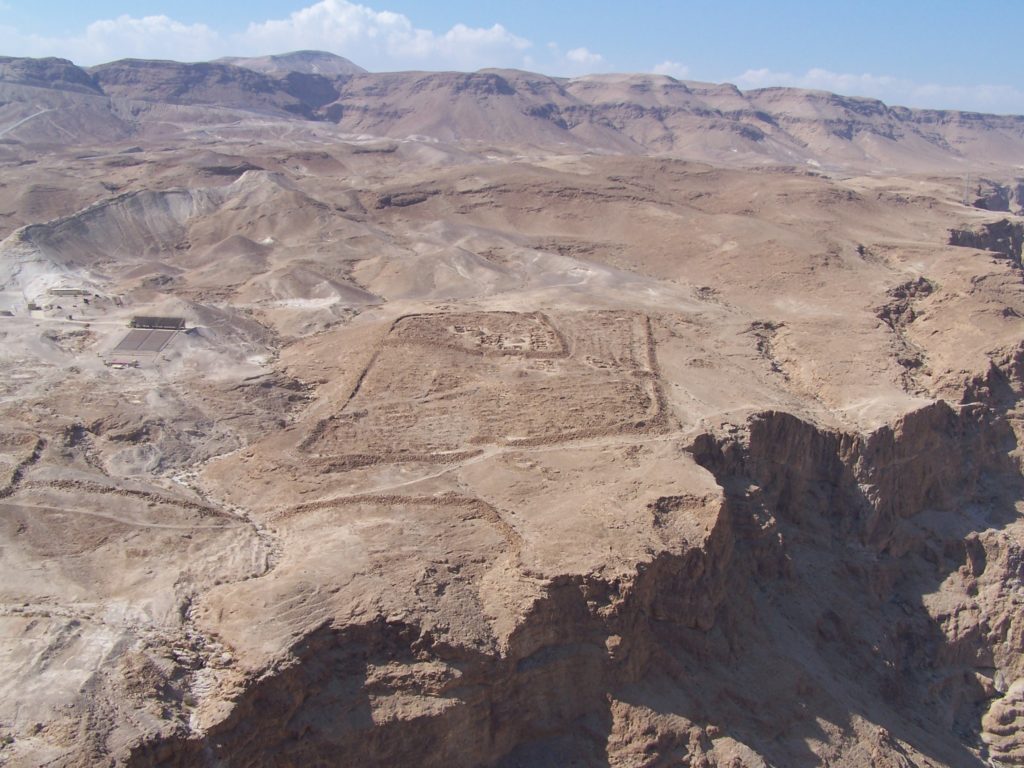
L7 ἕνεκεν ἐμοῦ (Luke 9:24). Three points lead us to the conclusion that the First Reconstructor added ἕνεκεν ἐμοῦ (heneken emou, “for my sake”) to the saying. First, the inclusion of “for my sake” creates an imbalance in the saying, since in the first half no reason is given why someone would want to save his life. “For my sake” thus has the appearance of an addition to an originally balanced saying. Second, the presence of “for my sake” in L7 transforms the entire saying into one about the personal cost of following Jesus. The version of Preserving and Destroying in Luke 17:33, which was based on Anth., makes no salvific claims about Jesus. Since it is improbable that a Christian writer would erase a soteriological statement about faith in (or faithfulness to) Jesus, it is more likely that the version of Preserving and Destroying that makes no such claim is original.[31] Third, if, as we believe, Luke 17:33 preserves the original context of Preserving and Destroying, the concept of losing one’s soul (by martyrdom?) for Jesus’ sake is out of place. In its original context as part of a discourse on the coming confrontation between the people of Israel and the Roman Empire, Preserving and Destroying is about forsaking one’s property in order to escape the onslaught of the Roman legions. The addition of “for my sake” to Preserving and Destroying reflects the First Reconstructor’s attempt to transform a saying of Jesus of limited application to one that was applicable at all times to all Jesus’ followers.[32]
L8 καὶ τοῦ εὐαγγελίου (Mark 8:35). The inclusion of “and for the Gospel” only increases the lopsidedness of the saying, and the omission of these words in the Lukan and Matthean parallels is a strong indication that they are a Markan flourish.[33] Indeed, we note that the noun εὐαγγέλιον (evangelion, “good news,” “gospel”) never occurs in the Gospel of Luke and in Mark’s Gospel always appears to be due to the author of Mark’s editorial activity.[34] As we noted in A Voice Crying, Comment to L1, the term εὐαγγέλιον was likely adopted by early Greek-speaking followers of Jesus as a shorthand for the totality of Jesus’ message, but it is unlikely that Jesus himself used a Hebrew term corresponding to εὐαγγέλιον. In a further development, the early Christians began to use the term εὐαγγέλιον to denote their own message about Jesus’ messianic status. The author of Mark may have intended this later sense when he added καὶ τοῦ εὐαγγελίου to his version of Preserving and Destroying.
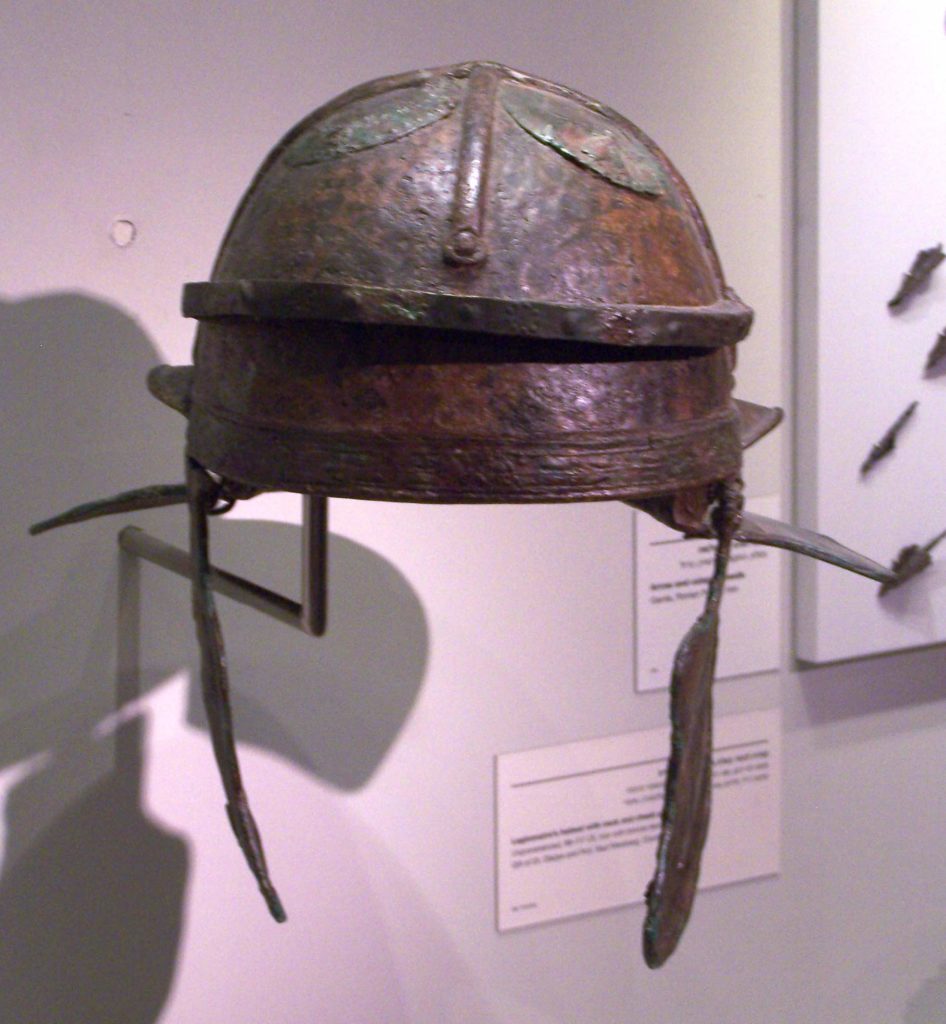
L9 εὑρήσει αὐτήν (Matt. 16:25). The words εὑρήσει αὐτήν (hevrēsei avtēn, “he will find it”) in Matt. 16:25 are due to cross-pollination from the highly redacted version of Preserving and Destroying in Matt. 10:39. The result is an odd combination of “saving,” “destroying/losing” and “finding” in Matt. 16:25.
ζῳογονήσει αὐτήν (GR). As we discussed in Comment to L3, the use of σῴζειν (“to save”) in the Lukan, Markan and Matthean versions of Preserving and Destroying stemming from FR is best ascribed to the First Reconstructor’s redaction. We also suggested that the use of two different Greek verbs for “preserve” and “keep alive” in L3 and L9 in the Lukan version of Preserving and Destroying stemming from Anth. probably reflects the use of verbs formed from different Hebrew roots in the Hebrew Life of Yeshua. Since ζῳογονεῖν (zōogonein, “to make alive,” “to preserve alive”) in Luke 17:33 reverts easily to Hebrew (see below), we have accepted ζῳογονήσει αὐτήν (zōogonēsei avtēn, “he will keep it alive”) for GR in L9.
יְקַיְּמֶהָ (HR). The verb ζῳογονεῖν is not common in LXX, but where it does occur it always does so as a translation of the ח-י-ה root.[35] There is one example in LXX where ζῳογονεῖν + ψυχή occurs as the translation of נֶפֶשׁ + חִיָּה:
וַיֹּאמְרוּ אֵלָיו עֲבָדָיו הִנֵּה־נָא שָׁמַעְנוּ כִּי מַלְכֵי בֵּית יִשְׂרָאֵל כִּי מַלְכֵי חֶסֶד הֵם נָשִׂימָה נָּא שַׂקִּים בְּמָתְנֵינוּ וַחֲבָלִים בְּרֹאשֵׁנוּ וְנֵצֵא אֶל מֶלֶךְ יִשְׂרָאֵל אוּלַי יְחַיֶּה אֶת נַפְשֶׁךָ
And his servants said to him, “Now look, we have heard that the kings of the house of Israel are merciful kings. So let us put sacking on our loins and ropes on our heads and go out to the king of Israel. Perhaps he will keep your soul alive [יְחַיֶּה אֶת נַפְשֶׁךָ; i.e., spare your life].” (1 Kgs. 20:31)
καὶ εἶπεν τοῖς παισὶν αὐτοῦ Οἶδα ὅτι βασιλεῖς Ισραηλ βασιλεῖς ἐλέους εἰσίν· ἐπιθώμεθα δὴ σάκκους ἐπὶ τὰς ὀσφύας ἡμῶν καὶ σχοινία ἐπὶ τὰς κεφαλὰς ἡμῶν καὶ ἐξέλθωμεν πρὸς βασιλέα Ισραηλ, εἴ πως ζωογονήσει τὰς ψυχὰς ἡμῶν
And he said to his servants, “I know that the kings of Israel are merciful kings. So let us put sacking on our waists and ropes on our heads and go out to the king of Israel. Perhaps he will keep our souls alive [ζωογονήσει τὰς ψυχὰς ἡμῶν; i.e., spare our lives].” (3 Kgdms. 21:31)
All this would seem to make a verb from the ח-י-ה root the obvious choice for HR, especially when we recall that in the story of the destruction of Sodom and Gomorrah Lot says to the angels who were rescuing him:
וַתַּגְדֵּל חַסְדְּךָ אֲשֶׁר עָשִׂיתָ עִמָּדִי לְהַחֲיוֹת אֶת נַפְשִׁי
…and you have increased your benevolence, which you have done to me by saving my life [לְהַחֲיוֹת אֶת נַפְשִׁי]…. (Gen. 19:19)
Nevertheless, in Mishnaic Hebrew the hif‘il verb הֶחֱיָה (heḥeyāh) was more often used in the sense of “cause to live” or even “restore to life” (i.e., in the sense of “resurrect”)—[36] the same is true of the pi‘el verb חִיָּה (ḥyāh)[37] —whereas “preserve” or “keep alive” was usually expressed with the verb קִיֵּם (qiyēm, “preserve alive,” “keep alive”).[38] An example of this usage can already be found in the Dead Sea Scrolls:
אל יילד איש בהמה ביום השבת ואם תפול אל בור ואל פחת אל יקימה בשבת…וכל נפש אדם אשר תפול אל מקום מים ואל [בו]ר אל יעלה איש בסולם וחבל וכלי
A man must not help a domesticated animal give birth on the Sabbath day. And if it falls into a cistern or into a pit he may not keep it alive [יְקַיְּמֶהָ][39] on the Sabbath. (CD XI, 13-14; corrected on the basis of 4Q271 5 I, 8-9)
Another important example of קִיֵּם in the sense of “keep alive” occurs in the Mishnah:
לְפִיכָךְ נִיבְרָא אָדָם יָחִיד בָּעוֹלָם לְלַמֵּד שֶׁכָּל הַמְאַבֵּד נֶפֶשׁ אַחַת מַעֲלִין עָלָיו כְּיִלּוּ אִבֵּד עוֹלָם מָלֵא וְכָל הַמְקַיֵּים נֶפֶשׁ אַחַת מַעְלִין עָלָיו כְּיִלּוּ קִיֵּים עוֹלָם מָלֵא
Therefore Adam was created unique in the world, in order to teach that everyone who destroys [הַמְאַבֵּד] one life [נֶפֶשׁ], they account it to him as though he had destroyed [אִבֵּד] an entire world, but everyone who preserves [הַמְקַיֵּים] one life [נֶפֶשׁ], they account it to him as though he had kept [קִיֵּים] the entire world alive. (m. Sanh. 4:5)
The relevance of this mishnaic statement to our pericope is clear. Here we find similar combinations of “destroy” and “preserve” with “soul/life,” confirming that קִיֵּם would fit comfortably in HR.
Given Mishnaic usage, the use of קִיֵּם (“keep alive”) with נֶפֶשׁ (“soul/life”), and the opposing pair קִיֵּם/אִבֵּד (“destroy/keep alive”), we think קִיֵּם is the best option for HR.
Redaction Analysis
Of the five versions of Preserving and Destroying in the Synoptic Gospels, that which is found in Luke 17:33 is closest to the original. It is easy to reconstruct in Hebrew, its message does not exhibit a christological soteriology, and when approached from a Hebraic perspective it is found to be entirely at home in the context of Days of the Son of Man and Lesson of Lot’s Wife, the two pericopae that precede it. Three other versions (Luke 9:24; Mark 8:35; Matt. 16:25) stem from FR’s paraphrase of Preserving and Destroying. It was this secondary form that gave Jesus’ saying a wider application and a christological twist. It is ironic that the version of Preserving and Destroying in Matt. 10:39 is the most highly redacted of the five versions despite being based on Anth. Matthean reworking of the saying and cross-pollination from the FR version account for the disparity between Matt. 10:39 and Anth.
Luke’s Versions[40]
| Preserving and Destroying | |||
| Luke 17:33 |
Anthology | ||
| Total Words: |
15 | Total Words: |
18 |
| Total Words Identical to Anth.: |
15 | Total Words Taken Over in Luke: |
15 |
| % Identical to Anth.: |
100.00 | % of Anth. in Luke: |
83.33 |
| Click here for details. | |||
.
| Preserving and Destroying | |||
| Luke 9:24 |
Anthology | ||
| Total Words: |
22 | Total Words: |
18 |
| Total Words Identical to Anth.: |
14 | Total Words Taken Over in Luke: |
14 |
| % Identical to Anth.: |
63.64 | % of Anth. in Luke: |
77.78 |
| Click here for details. | |||
Lukan redaction to Anth.’s version of Preserving and Destroying in Luke 17:33 is extremely limited, consisting only of the omission of the words τὴν ψυχὴν αὐτοῦ (“his soul”) in L6. The author of Luke probably dropped these words because doing so yielded a more succinct version of Jesus’ saying without changing its meaning. As far as we can tell, Lukan redaction to FR’s version of Preserving and Destroying in Luke 9:24 is non-existent. The saying had already been subjected to stylistic polishing at the hands of the First Reconstructor, with the result that the author of Luke saw no cause to make any improvements of his own. The author of Luke probably decided to keep both versions of Preserving and Destroying because the two versions have different meanings and because when copying blocks of material from his sources the author of Luke preferred to keep those blocks intact.
Mark’s Version[41]
| Preserving and Destroying | |||
| Mark | Anthology | ||
| Total Words: |
24 | Total Words: |
18 |
| Total Words Identical to Anth.: |
13 | Total Words Taken Over in Mark: |
13 |
| % Identical to Anth.: |
54.17 | % of Anth. in Mark: |
72.22 |
| Click here for details. | |||
Mark’s version of Preserving and Destroying, being based on Luke 9:24, stems from FR. There are only three (or possibly four) changes the author of Mark made to his version of the saying. In L9 the author of Mark dropped οὗτος (houtos, “this”), which he probably deemed superfluous. In L8 the author of Mark added καὶ τοῦ εὐαγγελίου (“and for the Gospel”). In L2 the author of Mark may have written τὴν ἑαυτοῦ ψυχήν (“his own soul”) instead of τὴν ψυχὴν αὐτοῦ (“his soul”), but there is not textual agreement on this point. And in L1 the author of Mark wrote ἐάν instead of ἄν, which happens to agree with the ἐάν in Luke 17:33 and presumably in Anth. The author of Mark may have been influenced by Luke 17:33 or Anth. on this point, but so minor a change could also be mere coincidence.
Matthew’s Versions[42]
| Preserving and Destroying | |||
| Matthew (Anth.) | Anthology | ||
| Total Words: |
17 | Total Words: |
18 |
| Total Words Identical to Anth.: |
9 | Total Words Taken Over in Matt.: |
9 |
| % Identical to Anth.: |
52.94 | % of Anth. in Matt.: |
50.00 |
| Click here for details. | |||
.
| Preserving and Destroying | |||
| Matthew (FR via Mark) | Anthology | ||
| Total Words: |
21 | Total Words: |
18 |
| Total Words Identical to Anth.: |
15 | Total Words Taken Over in Matt.: |
15 |
| % Identical to Anth.: |
71.43 | % of Anth. in Matt.: |
83.33 |
| Click here for details. | |||
Matthean cross-pollination and creative reinterpretation accounts for the considerable differences between the version of Preserving and Destroying in Matt. 10:39 and Anth. Cross-pollination from the Markan version of Preserving and Destroying is exhibited in two ways: 1) the linking of Preserving and Destroying to a preceding cross-bearing saying (Matt. 10:38 ∥ Matt. 16:24); and 2) the introduction of the christological motif in L7 (ἕνεκεν ἐμοῦ). The author of Matthew’s independent creativity is displayed in his transformation of a saying about saving or losing one’s life (as in Mark 8:35 and Luke 9:24) into one about finding or losing one’s soul.
Matthew’s version of Preserving and Destroying in Matt. 16:25, despite stemming from FR via Mark, is actually much closer to the wording of Anth. because it was subjected to much less Matthean redaction. There are only two (or possibly three) changes the author of Matthew made to Preserving and Destroying in Matt. 16:25: 1) the author of Matthew may have changed Mark’s τὴν ἑαυτοῦ ψυχήν (“his own soul”) to τὴν ψυχὴν αὐτοῦ (“his soul”), but the text of Mark 8:35 is not certain on this point; 2) the author of Matthew omitted καὶ τοῦ εὐαγγελίου (“and for the Gospel”) in L8; and 3) the author of Matthew wrote εὑρήσει αὐτήν (“he will find it”) in L9 instead of σώσει αὐτήν (“he will save it”). This last change is the only instance of cross-pollination from the version in Matt. 10:39.
Results of This Research
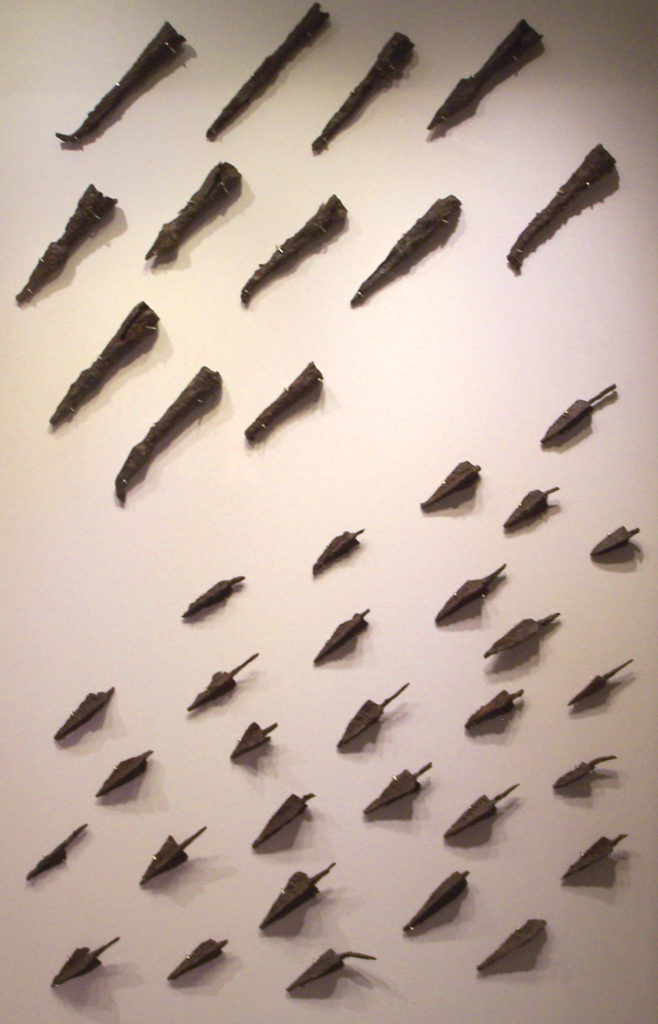
1. Is Preserving and Destroying a saying about risking one’s life for Jesus? In the two Matthean versions of Preserving and Destroying (Matt. 10:39; 16:25) and the two versions of Preserving and Destroying in Mark 8:35 and Luke 9:24 the saying probably is about the risk of martyrdom on account of faithfulness to Jesus. However, it is likely that this take on Preserving and Destroying is a reinterpretation of a saying that originally had an entirely different application. A Hebraic approach to Preserving and Destroying reveals that this saying coheres admirably with Jesus’ use of the story of Lot’s flight from Sodom to illustrate how his contemporaries should act when the military clash with Rome that Jesus predicted finally takes place.
Conclusion
In Preserving and Destroying Jesus continued his use of the story of Lot’s flight from Sodom to illustrate how his contemporaries should behave when war with the Roman Empire erupts. According to Jewish tradition, Lot’s hesitation over his belongings nearly proved fatal to himself, his wife and his daughters. From Lot’s example Jesus warned the members of his generation to forsake their possessions and run if they wanted to survive the onslaught of the Roman legions.
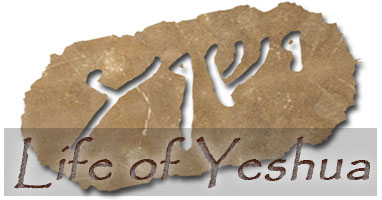 Click here to return to The Life of Yeshua: A Suggested Reconstruction main page.
_______________________________________________________
Click here to return to The Life of Yeshua: A Suggested Reconstruction main page.
_______________________________________________________
- [1] For abbreviations and bibliographical references, see “Introduction to ‘The Life of Yeshua: A Suggested Reconstruction.’” ↩
- [2] This translation is a dynamic rendition of our reconstruction of the conjectured Hebrew source that stands behind the Greek of the Synoptic Gospels. It is not a translation of the Greek text of a canonical source. ↩
- [3] The Hebrew reconstruction appears in Menahem Kister, “Plucking on the Sabbath and Christian-Jewish Polemic,” Immanuel 24/25 (1990): 35-51, esp. 42 n. 25. The English translation of his reconstruction is our own. ↩
- [4] Scholars approaching the question from the perspective of Markan Priority generally conclude that the author of Luke injected Preserving and Destroying into the Son of Man materials found in Luke 17. See Kloppenborg, 158-159. Bovon (2:514), while regarding Luke 17:33 as an insertion, noted that such insertions were a departure from the author of Luke’s usual habit of concentrating on one source at a time. ↩
- [5] On Anth.’s block of Son of Man material in Luke 17, see Days of the Son of Man, under the subheading “Story Placement.” ↩
- [6] It appears to be the author of Matthew who separated the Darnel Among the Wheat parable from the Bad Fish Among the Good parable. Likewise, it was the author of Luke who separated the Persistent Widow parable from Friend in Need. ↩
- [7] So, for example, the Anthologizer attached Like Children Complaining to the end of a discourse unit about John the Baptist (see the introduction to the “Yohanan the Immerser and the Kingdom of Heaven” complex), and he attached Woes on Three Villages to the end of the Sending the Twelve discourse (see Woes on Three Villages, under the subheading “Story Placement”). ↩
- [8] We have found one example of the Anthologizer’s injection of a pericope into the middle of a block: attaching the Father and Son saying to Yeshua’s Thanksgiving Hymn in the middle of a block pertaining to the return of the apostles from their healing and teaching mission. However, this is an exception that proves the rule. It is clear why the Anthologizer attached Father and Son to Yeshua’s Thanksgiving Hymn: the two pericopae have similar themes and vocabulary (father-son relationship, revelation). Preserving and Destroying, on the other hand, does not share obvious themes or vocabulary with Lesson of Lot’s Wife or Indiscriminate Catastrophe that would have led the Anthologizer to attach Preserving and Destroying to either pericope.
See Yeshua’s Thanksgiving Hymn, under the “Story Placement” subheading, for a discussion of the Anthologizer’s insertion of Father and Son following Yeshua’s Thanksgiving Hymn. ↩ - [9] The author of Luke did occasionally inject foreign pericopae into large blocks of material inherited from an earlier source. Thus, the author of Luke injected Mysteries of the Kingdom of Heaven into a block of material otherwise taken from FR. See the introduction to the “Four Types of Hearers” complex and Mysteries of the Kingdom of Heaven, under the “Story Placement” subheading. Likewise, the author of Luke injected Pharisees Reject God’s Purpose (Luke 7:29-30) into a block of material otherwise taken from Anth. See the introduction to the “Yohanan the Immerser and the Kingdom of Heaven” complex. ↩
- [10] Cf. Manson (Sayings, 145), who concluded that Luke 17:33 represents the “Q” location of Preserving and Destroying. ↩
- [11] There is a rabbinic wordplay on וַיִּתְמַהְמָהּ (vayitmahmāh, “and he lingered”; Gen. 19:16) and תִּמָּהוֹן (timāhōn, “hesitation”). ↩
- [12] In the version of this tradition found in Yalkut Shim‘oni §84 the text reads במה אברר (“What should I pick?”) instead of כמה אבוד (“What destruction!”) as in Gen. Rab. 50:11. The two versions are graphically similar and both make sense in context. ↩
- [13] For the angels’ rebuke of Lot in its larger context, see Lesson of Lot’s Wife, Comment to L3. ↩
- [14] Instances of נֶפֶשׁ with the meaning “desire” occur in Biblical and Mishnaic Hebrew. In the Hebrew Scriptures we read:
וְהָיָה אִם־לֹא חָפַצְתָּ בָּהּ וְשִׁלַּחְתָּהּ לְנַפְשָׁהּ
And it will be that if you no longer desire her [i.e., a woman captured in battle—DNB and JNT], you must send her away according to her desire [לְנַפְשָׁהּ; i.e., wherever she wishes to go—DNB and JNT]. (Deut. 21:14; cf. Jer. 34:16)
וַיְנַסּוּ אֵל בִּלְבָבָם לִשְׁאָל אֹכֶל לְנַפְשָׁם
And they tested God in their heart, asking for food according to their desire [לְנַפְשָׁם; LXX: ταῖς ψυχαῖς αὐτῶν]. (Ps. 78:18)
The example from Psalm 78 shows that the LXX translators did not always understand the intended nuance of נֶפֶשׁ, or at least they did not know how to represent this meaning of נֶפֶשׁ in Greek. Whereas in Hebrew it is understood that the Israelites tested God by demanding foods they craved, in the Greek translation it appears that the Israelites simply asked for food to stay alive.
In Mishnaic Hebrew, too, נֶפֶשׁ can mean “desire.” See Jastrow, 926-927. Some examples of this usage are found in the following midrashic text:
↩לפי שנתן דוד נפשו עליו לבנותו נקרא על שמו…וכן אתה מוצא שכל דבר שאדם נותן נפשו עליו נקרא על שמו
Because David set his desire [נָתַן דָּוִד נַפְשׁוֹ; lit., David gave his soul] on building it [i.e., the Temple—DNB and JNT], it was called by his name…. And so you find that everything upon which a person sets his desire [אָדָם נוֹתֵן נַפְשׁוֹ] is called by his name. (Mechilta de-Rabbi Ishmael, Shirata §1 [ed. Lauterbach, 1:170])
- [15] It was precisely because he understood Preserving and Destroying to be a paradox that Bundy (390 §300) declared that Preserving and Destroying “breaks into the continuity of the discourse.” According to Bundy, Preserving and Destroying contradicts the advice given in Lesson of Lot’s Wife to abandon one’s property, since according to his paradoxical interpretation of Jesus’ saying, any effort to save one’s life (such as taking flight) results in its forfeiture. Our Hebraic approach to Preserving and Destroying, on the other hand, does not contradict but reinforces Lesson of Lot’s Wife and continues with the theme of Lot’s departure from Sodom. ↩
- [16] Cf. Joachim Jeremias, Unknown Sayings of Jesus (trans. Reginald H. Fuller; 2d ed.; London: SPCK, 1964), 77-78. Because of Jeremias’ unfortunate method of Scripture citation, in which he gave only the first verse + “f.” to indicate a pericope (e.g., Luke 17.31f.), it is impossible to know whether Jeremias considered Luke 17:33 to be an organic part of Lesson of Lot’s Wife. It would make sense if he had, given that he discusses an extra-canonical saying attributed to Jesus (σῴζου σὺ καὶ ἡ ψυχή σου [“Save yourself and your soul”]; Clement of Alexandria, Excerpta ex Theodoto 2:2) which more closely resembles Preserving and Destroying (Luke 17:33) than Lesson of Lot’s Wife (Luke 17:31-32). ↩
- [17] See Robert L. Lindsey, “From Luke to Mark to Matthew: A Discussion of the Sources of Markan ‘Pick-ups’ and the Use of a Basic Non-canonical Source by All the Synoptists,” under the subheading “Sayings Doublets”; idem, TJS, 36-37. ↩
- [18] On the small collections of sayings we refer to as “strings of pearls” scattered about in Luke’s Gospel as stemming from FR, see LOY Excursus: Sources of the “Strings of Pearls” in Luke’s Gospel. ↩
- [19] On the author of Matthew’s construction of the Matthean version of the Sending the Twelve Discourse, see the introduction to the “Mission of the Twelve” complex. ↩
- [20] It is possible that ψυχή (“soul”) was a catchword that led to the lumping together of the FR versions of Demands of Discipleship (Luke 9:23), Preserving and Destroying (Luke 9:24), and the saying in Luke 9:25, which Lindsey believed was a paraphrase of the point of the Rich Fool parable. Although the term ψυχή does not appear in Luke 9:23 or Luke 9:25, ψυχή does appear in the Anth. parallels to these verses (Luke 14:26-27 ∥ Luke 9:23; Luke 12:20 ∥ Luke 9:25) (see LOY Excursus: Sources of the “Strings of Pearls” in Luke’s Gospel, under the subheading “Lukan Doublets”). In that case, the First Reconstructor drew these sayings together because they included the word ψυχή in Anth., but when the First Reconstructor paraphrased these sayings he was not concerned to preserve the word ψυχή, which had been the catalyst for bringing them together. ↩
- [21] See Yeshua, His Mother and Brothers, Comment to L19. ↩
- [22] See Yeshua, His Mother and Brothers, Comment to L19. ↩
- [23] Pace Bovon, 2:522. ↩
- [24] Pace Nolland (Luke, 2:861), who attributed the verbal differences of Luke 17:33 from the wording in Luke 9:24 ∥ Mark 8:35 to Lukan redaction. ↩
- [25] On σῴζειν as an FR redactional term, see Four Soils Interpretation, Comment to L34. ↩
- [26] See Hatch-Redpath, 2:1125. ↩
- [27] Bridge, in his discussion of Lesson of Lot’s Wife, noted the high frequency of references to “saving” a “soul” that occurs in the story of Lot and his family’s escape from Sodom. See Steven L. Bridge, ‘Where the Eagles are Gathered’: The Deliverance of the Elect in Lukan Eschatology (Sheffield: Sheffield Academic Press, 2003), 46. ↩
- [28] See Dos Santos, 113. ↩
- [29] Cf. Kister’s reconstruction of Preserving and Destroying quoted in the Reconstruction section above. ↩
- [30] The LXX translation of Ezek. 22:27 lacks a Greek equivalent to the phrase לְאַבֵּד נְפָשׁוֹת (le’abēd nefāshōt, “to destroy souls”). ↩
- [31] Cf. Bundy, 390 §300; Bovon, 2:522. ↩
- [32] Cf. Bultmann, 93; Collins, 409. ↩
- [33] Cf. Taylor, 382. ↩
- [34] See LOY Excursus: Catalog of Markan Stereotypes and Possible Markan Pick-ups, under the entry for Mark 1:1. ↩
- [35] See Hatch-Redpath, 1:601. ↩
- [36] See Jastrow, 454. ↩
- [37] Examples of חִיָּה in the sense of “resurrect” or “bring [back] to life” occur in phrases from the Amidah, such as מְחַיֵּה מֵתִים אַתָּה רַב לְהושִׁיעַ (“Restorer of the Dead, you are mighty to save”) and מֶלֶךְ מֵמִית וּמְחַיֶּה וּמַצְמִיחַ יְשׁוּעָה (“O king, who kills and restores to life and causes salvation to sprout forth”). ↩
- [38] A blessing recited on holy days demonstrates the subtle difference between the use of הֶחֱיָה (“cause to live”) and קִיֵּם (“keep alive,” “preserve”) in Mishnaic Hebrew: בָּרוּךְ אַתָּה יי אֱלֹהֵנוּ מֶלֶךְ הָעוֹלָם שֶׁהֶחֱיָנוּ וְקִיְּמָנוּ וְהִגִּיעָנוּ לַזְּמַן הָזֶּה (“Blessed are you, O LORD, our God, king of the universe, who has given us life [שֶׁהֶחֱיָנוּ], and preserved us [וְקִיְּמָנוּ], and brought us to this season”). ↩
- [39] On reading יקימה as a pi‘el verb (“he will preserve it”) rather than as a hif‘il (“he will raise it”), see Jan Joosten and Menahem Kister, “The New Testament and Rabbinic Hebrew,” in The New Testament and Rabbinic Literature (Reimund Bieringer; Florentio García Martinez, Didier Pollefeyt and Peter J. Tomson, eds.; Leiden: Brill, 2010), 335-350, esp. 341-342. ↩
- [40]
Preserving and Destroying Luke’s Anth. Version Anthology’s Wording (Reconstructed) ὃς ἐὰν ζητήσῃ τὴν ψυχὴν αὐτοῦ περιποιήσασθαι ἀπολέσει αὐτήν ὃς δ᾿ ἂν ἀπολέσῃ ζῳογονήσει αὐτήν ὃς ἐὰν ζητήσῃ τὴν ψυχὴν αὐτοῦ περιποιήσασθαι ἀπολέσει αὐτήν ὃς δ᾿ ἂν ἀπολέσῃ τὴν ψυχὴν αὐτοῦ ζῳογονήσει αὐτήν Total Words: 15 Total Words: 18 Total Words Identical to Anth.: 15 Total Words Taken Over in Luke: 15 Percentage Identical to Anth.: 100.00% Percentage of Anth. Represented in Luke: 83.33% .
Preserving and Destroying Luke’s FR Version Anthology’s Wording (Reconstructed) ὃς γὰρ ἂν θέλῃ τὴν ψυχὴν αὐτοῦ σῶσαι ἀπολέσει αὐτήν ὃς δ᾿ ἂν ἀπολέσῃ τὴν ψυχὴν αὐτοῦ ἕνεκεν ἐμοῦ οὗτος σώσει αὐτήν ὃς ἐὰν ζητήσῃ τὴν ψυχὴν αὐτοῦ περιποιήσασθαι ἀπολέσει αὐτήν ὃς δ᾿ ἂν ἀπολέσῃ τὴν ψυχὴν αὐτοῦ ζῳογονήσει αὐτήν Total Words: 22 Total Words: 18 Total Words Identical to Anth.: 14 Total Words Taken Over in Luke: 14 Percentage Identical to Anth.: 63.64% Percentage of Anth. Represented in Luke: 77.78% ↩
- [41]
Preserving and Destroying Mark’s Version (FR via Luke) Anthology’s Wording (Reconstructed) ὃς γὰρ ἐὰν θέλῃ τὴν ἑαυτοῦ ψυχὴν σῶσαι ἀπολέσει αὐτήν ὃς δ᾿ ἂν ἀπολέσει τὴν ψυχὴν αὐτοῦ ἕνεκεν ἐμοῦ καὶ τοῦ εὐαγγελίου σώσει αὐτήν ὃς ἐὰν ζητήσῃ τὴν ψυχὴν αὐτοῦ περιποιήσασθαι ἀπολέσει αὐτήν ὃς δ᾿ ἂν ἀπολέσῃ τὴν ψυχὴν αὐτοῦ ζῳογονήσει αὐτήν Total Words: 24 Total Words: 18 Total Words Identical to Anth.: 13 Total Words Taken Over in Mark: 13 Percentage Identical to Anth.: 54.17% Percentage of Anth. Represented in Mark: 72.22% ↩
- [42]
Preserving and Destroying Matthew’s Version (Anth.) Anthology’s Wording (Reconstructed) ὁ εὑρὼν τὴν ψυχὴν αὐτοῦ ἀπολέσει αὐτήν καὶ ὁ ἀπολέσας τὴν ψυχὴν αὐτοῦ ἕνεκεν ἐμοῦ εὑρήσει αὐτήν ὃς ἐὰν ζητήσῃ τὴν ψυχὴν αὐτοῦ περιποιήσασθαι ἀπολέσει αὐτήν ὃς δ᾿ ἂν ἀπολέσῃ τὴν ψυχὴν αὐτοῦ ζῳογονήσει αὐτήν Total Words: 17 Total Words: 18 Total Words Identical to Anth.: 9 Total Words Taken Over in Matt.: 9 Percentage Identical to Anth.: 52.94% Percentage of Anth. Represented in Matt.: 50.00% .
Preserving and Destroying Matthew’s Version (FR via Mark) Anthology’s Wording (Reconstructed) ὃς γὰρ ἐὰν θέλῃ τὴν ψυχὴν αὐτοῦ σῶσαι ἀπολέσει αὐτήν ὃς δ᾿ ἂν ἀπολέσῃ τὴν ψυχὴν αὐτοῦ ἕνεκεν ἐμοῦ εὑρήσει αὐτήν ὃς ἐὰν ζητήσῃ τὴν ψυχὴν αὐτοῦ περιποιήσασθαι ἀπολέσει αὐτήν ὃς δ᾿ ἂν ἀπολέσῃ τὴν ψυχὴν αὐτοῦ ζῳογονήσει αὐτήν Total Words: 21 Total Words: 18 Total Words Identical to Anth.: 15 Total Words Taken Over in Matt.: 15 Percentage Identical to Anth.: 71.43% Percentage of Anth. Represented in Matt.: 83.33% ↩


